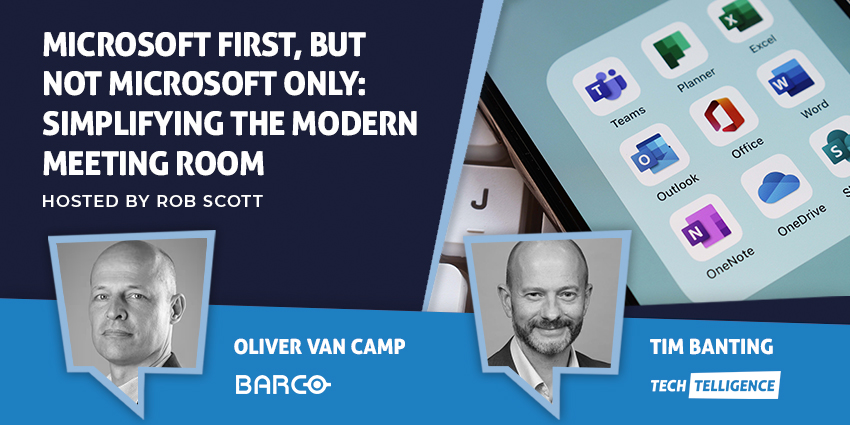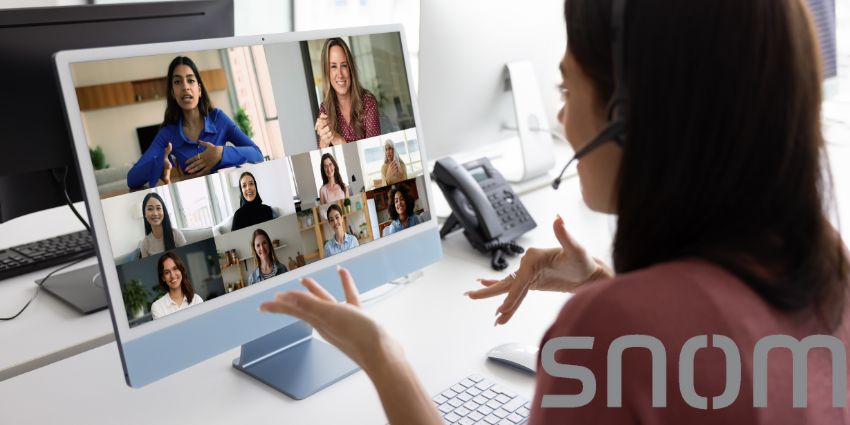Meeting room device management has become increasingly complex. Previously, IT admins would manually check hardware in a limited number of spaces to ensure everything was updated and secure. Today, devices are spread across an ever-growing number of collaboration environments, across floors, buildings, and global office locations, and are supported by sophisticated, IoT-enabled management solutions that offer expanding features and numerous customizable integration options.
To optimize their infrastructure, IT decision-makers are increasingly focusing on vendor consolidation—centralizing IT products and services through a smaller number of trusted vendors capable to support dynamic collaboration use cases and needs. This approach streamlines operations, reduces costs, and simplifies the complexities inherent in managing a multi-faceted IT environment. Vendor consolidation is not merely a trend but a strategic necessity, facilitating cohesive ecosystems that allow for seamless integration and superior support.
As organizations look to consolidate, they face a choice between leveraging traditional Remote Monitoring and Management (RMM) tools and adopting vendor-specific cloud management solutions. Here we give a detailed comparison and delve into the critical considerations around these two types of tools to help you make informed choices that align with your objectives.
Use Cases & Differentiation
RMM tools have long stood as the cornerstone of IT service management. Offering a unified platform with extensive capabilities, they enable integrators and large organizations to monitor and manage diverse IT and AV infrastructures, networks, and cloud environments. Solutions such as AVI-SPL Symphony, Diversified Pulse, Utelogy U-Manage, N-able RMM, ConnectWise Automate, and Datto RMM provide comprehensive oversight across various brands and device types, ensuring efficient management of all equipment within complex infrastructures.
In contrast, the growing sophistication of vendor-specific management solutions presents an enticing alternative. Leveraging deep integration with IoT-enabled hardware and software, these tools deliver advanced functionalities tailored to a specific vendor’s ecosystem. Vendor-specific tools are advantageous and offer an optimized management experience particularly for large educational institutions or corporate environments standardized on equipment from a single or few vendors. Examples of such proprietary tools include ShureCloud, Q-SYS Reflect, AMX RMS, AWS Management Console, Azure Portal and Google Cloud Console.
Integration Capabilities
Vendor-specific tools typically limit integration to devices from the same manufacturer. They excel at offering advanced features and optimizations for those specific devices but lack the ability to integrate seamlessly with hardware from other brands. In the realm of cross-platform integration, however, solutions like ShureCloud are advancing with cloud-to-cloud initiatives, specifically targeting commonly used platforms like ServiceNow for service ticketing when issues are detected, adding a layer of automated support within a specialized Shure ecosystem.
Conversely, RMM tools provide extensive integration capabilities, allowing users to monitor and manage devices from numerous manufacturers. This is advantageous in complex, mixed-brand environments, providing a single pane of glass for managing all devices. However, achieving this unified view often requires extensive, custom programming and setup.
Customization and Flexibility
Vendor-specific tools often shine through their highly specialized features and settings tailored to the manufacturer’s devices, but may offer limited customization options beyond that ecosystem. RMM tools, on the other hand, are designed to offer extensive customization and flexibility, enabling users to adapt to various organizational requirements and operational nuances with custom alerts, reports, and dashboards.
Security Considerations
Security is another critical aspect where these tools differ significantly. Vendor-specific cloud management platforms provide robust security features designed for the devices they manage. However, organizations with strict security policies, like large financial institutions, might prefer RMM tools for their ability to monitor solutions within an internal network, avoiding the exposure of AV devices to the internet. RMM tools can be deployed on-premises or in the cloud, offering flexible security configurations to meet stringent requirements.
Analytics and Reporting
When it comes to analytics and reporting, vendor-specific tools can offer detailed insights, again tailored to the manufacturer’s devices. For example, ShureCloud can send alerts and notifications about device status changes via email or SMS. RMM tools extend such capabilities across all managed devices, providing comprehensive reporting on usage, performance, and potential issues, helping organizations make informed decisions about equipment utilization and maintenance.
Community and Support
Finally, vendor-specific tools often come with dedicated support and a community focused on the manufacturer’s devices, offering in-depth, tailored assistance and resources to enhance user experience. RMM tools typically provide broader support, accommodating a wide range of devices and manufacturers. They benefit from large user communities that can offer diverse insights and solutions across different sectors and technical challenges.
The Best of Both Worlds
Vendors of AV and collaboration solutions like Shure bridge the gap between specialized vendor cloud services and integrated RMM solutions. Shure supports diverse needs and preferences through two distinct solutions: ShureCloud and Shure System API. Both are designed to offer advanced functionalities and integration flexibility for a tailored management experience.
ShureCloud is a comprehensive portal that extends beyond traditional IoT device and license management to encompass complete vendor support and engagement services. It offers users a gateway to product resources, purchasing, training systems, and more, enhancing the overall user experience and support. As a cloud-native solution, ShureCloud continuously delivers innovations and integrations that surpass the limitations of traditional on-premise platforms.
Meanwhile, the Shure System API allows Shure’s sophisticated devices to integrate seamlessly with existing IT management solutions, including RMM tools. This provides robust Shure device monitoring functionalities within larger, diverse AV and IT ecosystems, benefiting managed service providers and in-house IT teams supporting mixed-vendor technology environments.
Conclusion
Considering the trend towards vendor consolidation, vendor-specific cloud management solutions like ShureCloud are increasingly valuable. They centralize IoT device management, offer continuous feature delivery, and provide extensive support tools for seamless vendor engagement.
On the other hand, REST APIs such as the Shure System API are indispensable for complex, multi-brand RMM integrations. Though they require custom setup, they offer comprehensive monitoring across diverse ecosystems.
By providing options for both scenarios, vendor partners like Shure offer flexible solutions that cater to exclusive Shure environments and mixed-brand setups alike. This dual approach empowers IT professionals to maintain a unified overview of their infrastructure while leveraging extensive vendor services, which ultimately delivers a balanced and efficient management experience tailored to modern IT needs.







